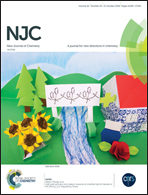An intense luminescent Dy(iii) single-ion magnet with the acylpyrazolonate ligand showing two slow magnetic relaxation processes†
Abstract
A new Dy(III) complex formulated as [Dy(pmap)3(H2O)2]·0.375CH3COOC2H5 (1) (pmap− = 1-phenyl-3-methyl-4-acetyl-5-pyrazolonate) has been synthesized and characterized. Single crystal X-ray analysis revealed that 1 crystallizes in the triclinic space group P![[1 with combining macron]](https://www.rsc.org/images/entities/char_0031_0304.gif) with two crystallographically independent mononuclear molecules (denoted as Dy1 and Dy2 moieties, respectively) in its unit cell. The investigation of photophysical properties showed that 1 displays intense yellow-light emission of Dy(III) ions with a notable lifetime value of 12.75 μs. Magnetic measurement demonstrated that 1 exhibits single ion magnet (SIM) behavior with two slow magnetic relaxation processes under a 2 kOe direct-current (dc) field. Two distinct slow magnetic relaxation processes can be attributed to the presence of two Dy(III) centers with different coordination geometries (square antiprism for Dy1 and triangular dodecahedron for Dy2). Moreover, the assignment of two relaxation processes to Dy1 and Dy2, respectively, was elucidated. All these features suggest that 1 is a potential bifunctional material combining luminescent and SIM properties within one molecule. Moreover, 1 represents the first SIM with an intense luminescent property based on the acylpyrazolonate ligand.
with two crystallographically independent mononuclear molecules (denoted as Dy1 and Dy2 moieties, respectively) in its unit cell. The investigation of photophysical properties showed that 1 displays intense yellow-light emission of Dy(III) ions with a notable lifetime value of 12.75 μs. Magnetic measurement demonstrated that 1 exhibits single ion magnet (SIM) behavior with two slow magnetic relaxation processes under a 2 kOe direct-current (dc) field. Two distinct slow magnetic relaxation processes can be attributed to the presence of two Dy(III) centers with different coordination geometries (square antiprism for Dy1 and triangular dodecahedron for Dy2). Moreover, the assignment of two relaxation processes to Dy1 and Dy2, respectively, was elucidated. All these features suggest that 1 is a potential bifunctional material combining luminescent and SIM properties within one molecule. Moreover, 1 represents the first SIM with an intense luminescent property based on the acylpyrazolonate ligand.



 Please wait while we load your content...
Please wait while we load your content...